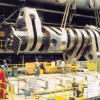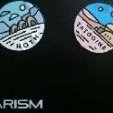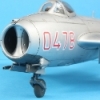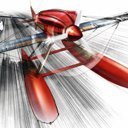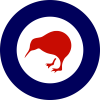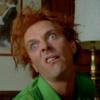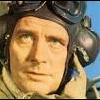Leaderboard
Popular Content
Showing content with the highest reputation on 15/03/19 in Posts
-
Bristol F.2B "Fighter the Crocodile" A year after start I was able to finish the build of this Brisfit last week, just in time to take part on exhibition and contest last weekend. This biplane was rewarded with a gold medal in 1/48 class. The model was build from a "Limited Edition" kit 1127 by Eduard in 1/48, but was enhanced with a lot of scratch builded parts from wood and metal. As usual I used paints form Alclad, Gunze, Mr.Paint and oils for weathering. This is definitely the model with the biggest effort until now, so from that point of view it is my masterpiece. And now the pictures! Cheers, Frank26 points
-
Hello, Here is my last building. This the old, but very nice mold - Ultracat seat - Yahu console - Quickboost exhaust - Decals from Xtradecal Enjoy25 points
-
Hello, this is a model from three years back, took part at the 35th IPMS Greece Nationals and won a Silver in Masters Category. I have used Eduard's BIG ED and resin wheels, Aires's beautiful resin Junkers Jumo 213 engine, Quickboost's resin propellers & resin MG151 barrels and Master's excellent turned brass antennas. Other than that, I have scratch built some detail inside the main and tail wheel wells, cut open the cockpit windows, opened the access hatch, cut open the ejector chutes for the underside MG151s and opened and scratch built the port side engine access panels. Colours are all Gunze according to their RLM range. Hope you like it, comments are most welcome! Alex.23 points
-
The model which I received to finish. The model that was started and lay in the box for several years. The model is A-7E Trumpeter which was to be made in painting from version D - it was the decision of the person for whom I finished this model. So we have an E version that pretends version D. In my opinion, the Trumpeter model itself is not very demanding and it will be easy to fold. However, you need to pay attention to the dividing lines that are too shallow and need improvement.22 points
-
And since this is a "zoom in" model here some additional shots with details. Have fun! A big effort was spend for rigging with "RAF wires", here are 188 scratched metall parts are used on the wings, on the fuselage there are additional ones: And finally a new shot with the medal: Cheers, Frank22 points
-
Well finished the Airfix 1/48 F.6, at last, to a Hunter made for two. Took pictures of the final ‘T’ bird only to notice that I’d forgotten to add the wing pitot, added a pic with the paint still wet. The only issues I had was sourcing the ‘WC’ decal that goes on the rear tail near the fin flash. Fantasy Printshop make a sheet for the XL573 Hunter, but I wasn't going to pay £20+for the 'WC' motif, had the other decals needed to hand. Thanks for looking. Greg.20 points
-
Here's my attempt at the Airfix Mk Vb (kit AO1525) finished as a tribute to Jean Offenberg a Belgium fighter pilot who came to Briton to help fight against tyranny in WWII. His exploits are documented in a book titled Lonely Warrior. Thanks for looking.16 points
-
This is my PZL P.24A in 1/72 scale built in autumn 2018. The model was built from Azur offering - cat. No A102 - PZL 24A/C Turkish Air Force. Aftermarket upgrading: YahuModels instrument panel and Master Model metal gun barrels. I have thoroughly reworked the surface structure and to some degree scratch detailed engine front area. There are quite many pictures here, but I hope you like them. Best from Szczecin, PL:15 points
-
15 points
-
Tamiya 1:48 Citroen 11cv. And on its' wee base: All Tamiya paints, Moltow 2mm Chrome pen for all the brightwork. Please feel free to hurl abuse, make a comment or ask a question. Have a great weekend everyone. Best from NZ. Ian.14 points
-
Model OOB, resin with PE, litle riveting and added some wires. Camo - feldfebel Jordan Ferdinandov -flying school Dolna Metropolija/Bulgaria - 30 march 1944. They only one battle mission of Avia - interception (formation 4 Avia's) 400 american bombers during mission over Sofia.14 points
-
Hi, Here is my 1/48 Sea Fury in Egyptian Markings. I believe this aircraft flown by Neville Duke Held the London to Cairo speed record obtained on its delivery flight.. OOB Airfix with Ventura Decals.. Painted in Tamiya Lacquer Silver. Thanks for looking...14 points
-
Thanks for checking PC. Appreciate it. Double @keefr22 gets a bit tetchy if people leave maps laying around the cockpit so I'm going to pretend they're labels..... You'll have to catch me first! I gather there's more grim weather coming the weekend - stay safe you crusty old barnacle if you're out saving souls in the MV Tentacle Conveyor. 🚢 Begone ye demon on my shoulder! Well, things do seem to be heading a specific direct Pheonix don't they? (And your own work has been a considerable inspiration in this regard!) Amen Brother CC. I noted during the week that a number of UK firms are now experimenting with four-day weeks for their staff. Surely this is the pro-modelling agenda going mainstream! Bits and bobs tonight. I've been evading those various 'tidy-up' jobs you get on every build for too long and decided before any further bits of construction to take care of some housekeeping. There were quite a few soldering iron burns in various places around the cockpit area and some breakthroughs on the nose where I'd had to thin down the fuselage walls to paper thickness in places. I used that CA & flour method that Giorgio and others have gotten such great results from and found it brilliant! Admittedly this is one of those photographs showing an sbsence of damage now but trust me that forward edge of the cockpit that the windshield fits onto was a right mess before and now has a nice sharp border again. There were about four or five other areas around the nose with damage that can no longer bee seen now either. Great technique and uber-tip of the chapeau to whatever canny lad first worked that one out. The missile tube in the port nose is a replacement gun recess (as you've clearly noted for yourselves) - I'll come back to that in a bit. Also finished off were the series of 'sills' top and bottom along the length of the windows and doors: The should also help with positioning the extensive glazing securely later on: To build the recessed fairing for the Browning was just the simple expedient of cutting down some 1.8mm brass tube and Gorilla Glueing it into place: After curing, this outer radius of the tubing was then sanded down flush to give a decent replacement for the original moulding: There's a pronounced 'lip' to that fairing that I'll try and catch later. The plan for the nose section is use metal foil to give it a sense of being a single subsection of the aircraft, plus there's wing fairings to cut out on the Silhouette later as well, so the gun fairing wil lget added then. I've also as you can see removed all of the too-prominent rivets around the wing and nose areas as well. Airfix did not catch the nose of the Mk.1 very skilfully I'm afraid: Squintest though at the hooter on yon beastie where a flat panel runs up to the front of the nose. Airfix had this as an upward curve, as well as just a bit too much roundedness to the actual front of the nose, and no windows at all. To correct this I firstly excised a section from the underside of the nose altogether using the jeweller's saw: The front of the nose was then filed to tone down the curved profile a little and a circular hole bored out for the front window using a series of successsively larger cylindrical birrs in the Dremel: To rebuild that underside, I've roughed out a blank cut from some scrap moulding from the Iron Chicken: The final shape of both it and the window opening won't get done until the fuselage is stuck together (for obvious reasons) but that should do nicely as a correction without being too complicated a procedure. Tomorrow I want to confront another job I've been tiptoeing around and fill out some representative fixtures for inside the nose. I'm not going to worry about the bomb-sight or having the lower bomb-aiming window open due to the nature of the mission, so that should simplify matters. Hope your own weeks have gone well. Evenin' all. Tony12 points
-
Great kit that goes together very well. There are a few "issues" though: first a boarding ladder is provide but cannot be used as it requires an open canopy with which the kit can't be built! Secondly, there are two different AAR probes provided, with zero guidance about which should be used. Thirdly - and potentially more confusing - there are two different ventral airbrakes & again with zero guidance about which should be used. I made a selection based upon nothing in particular & all was going well, until I went to fit the centre line fuel tank to the pylon I had attached.......it does not fit the gap in the airbrake which is presumably meant to fit around a store carried here! I am NOT an F-100 expert but I can only suppose that on the real thing, the airbrake is interchangeable according to whether & which centre line store is being carried but this seems an AWFUL lot of bother! Apart from this it was an enjoyable build. I used an Xtradecal sheet rather than trust the kit decals. This states that unusually for a USAF machine, the F-100 was PAINTED silver rather than NMF (similar to the RAF practice of using high speed silver). Accordingly the main scheme is AK aluminium with a mix of their titanium & bronze with jet exhaust streaks for the bare metal area around the engine. I'm happy with it.11 points
-
I have had this 1/72 scale Revell SE5 in the stash for years but was not too keen on building yet another bog standard green version. Then I saw a fellow modeller had produced a very nice 2 seater version and thought that I would have a go as it was a bit different. Nice easy build that I thoroughly enjoyed making this model. IMG_8504 by Ray Staley, on Flickr IMG_8464 by Ray Staley, on Flickr IMG_8545 by Ray Staley, on Flickr IMG_8553 by Ray Staley, on Flickr IMG_8586 by Ray Staley, on Flickr IMG_8590 by Ray Staley, on Flickr IMG_8595 by Ray Staley, on Flickr IMG_8594 by Ray Staley, on Flickr IMG_8595 by Ray Staley, on Flickr11 points
-
This is an F-86A-7 in the colours of 92nd Fighter Interceptor Squadron based at RAF Shepherds Grove, England in September 1952. The black wing bands denote temporary markings applied that same month for an exercise simulating a Korean War scenario and using the River Humber in place of the Yalu (The 92nd’s sister squadrons within the parent 81st Fighter Interceptor Wing used a single stripe (91st FIS) or no wing stripe (116th FIS)). And though the exercise order stated that only one wing per aircraft would be striped, many aircraft were painted on both wings and retained these markings as late as March 1953. By late 1952 the squadrons of 81st Fighter Interceptor Group had lost the colourful fuselage lightning flash they’d worn when they arrived in the UK during 1951; by early 1953 they began to wear ‘U.S.AIR FORCE’ stencils on the fuselage and the colourful tails also began to go at that time, replaced by more generic black-bordered yellow wing and tail bands akin to those worn by Korean War F-86s. Thus this model is a snapshot of a six-month period in the unit’s history. Note also that, despite what may have been written – or even modelled – before, all units of the 81st FIG had tails painted in mid blue with yellow lightning bolts. This colour combination is described a number of times in the official Wing and Group records, and corroborated by colour photographs. It’s based on the 1/48 Hasegawa/Eduard F-86F (‘Ultimate Sabre’ kit 1163) fuselage, mated to the narrow-chord, slatted wings of the Revell/Monogram F-86D (I used the ‘early’ version, kit 85-5868). Speed brake wells are rebuilt to reflect the uncluttered F-86A type; tail section extensively reworked and elevators also reworked to show mass balances of the A-version. Various vents and intakes were filled, modified or added, as necessary. Finally, the vee-shaped screen typical of the F-86A-5/6/7 was made using the modified plastic part from the Revell F-86D (it’s thicker than the Eduard version so gives you a bit more to work with), plus acetate vee-screen centre section. Paint is mainly airbrushed Mr Color acrylic, using white and black to darken and lighten various panel shades. F-86A-specific colours include the interior green landing gear bays, speed brakes and speed brake wells. Markings are a mix of masked tail lightning flashes and decals. Decals comprise mainly AeroMaster stencils (148-026 - F-86 Stencils); Caracal F-86 Buzz Numbers (CDB48002) and a few from the Eduard sheet. Canopy names and squadron badges are custom decals by Bedlam Creations (https://www.bedlamcreations.com/). The WIP is here: https://www.britmodeller.com/forums/index.php?/topic/235050524-f-86a-in-148/&10 points
-
Well, I headed down to the mailroom today, and happy birthday to me: Rest assured the St Patrick's Day paraphernalia in the back belongs to my cubicle mate, not me.9 points
-
FUSE PANEL ,RADIO ROOM HATCH AND CONTROL CABLES! Hi guys Hows it all going in the model world? Here we have the next installment of the radio room build for this B17G...as the the title states I managed to get 3 things completed since the last post....so starting with the fuse box here are some photos............ Quite straight forward really...a thickish piece of plastic was cut and manipulated into the fuse box!! It was then painted and cables added to it ....and here it is installed in it's rightful position! I then played around with the radio room hatch by adding the 4 escape/securing handles....basically I bent a sliver of aluminum from a cola can Then started the real fun and games! I never thought that adding the control cables would be such a pain!..I mean I put the cables into the nose section and the bomb bay without the blasted hassle I had this time.....is was all done by trial and error...starting over twice as I just couldn't get it to look right...I tried different gauges of electrical wire....I even tried using some fishing line!..the glue wouldn't set or I couldn't get the cables to tighten...but in the end I found some other small gauge electrical wire which wouldn't bend and made some guiders(for want of a better word) so that the cables were at equal distances to each other!.... Not sure if I know what I'm talking about!!😟....so here are the photos of the end result!! Oh .....I also sprayed the internal walls and placed the two window perspex on either side of the fuselage. So that's it for another week guys.........thanks a lot for looking in Laters Fozzy9 points
-
Eduard 1/48 scale Mirage IIIC weekend kit. Seat modified with spare parts and Tamiya tape, master pitot tube, modifications for South African RIMS upgrade package (sensors, flares), decals from my custom decal sheet, otherwise it's OOB build. Not a perfect or cleanest build, but I am happy with results.8 points
-
Dear comrades... This year has been a good year for me. I've rediscovered the hobby, and I've completed 4 models This post is to share with you my last work, the Great Wall Hobby F-15D 1/48 kit. Additionally, I've added aftermarkets ejection seats and exhaust noozles. Next we have uploade some photos, but a complete album is hosted on Flickr: https://www.flickr.com/photos/104148904@N02/albums/721577034318015418 points
-
I had this kit in the stash for a very long time, but kept overlooking it because of rigging. However I broke it out recently and decided to have a crack. The kit is basic, but decent fitting. I only replaced the lewis gun with one from the stash which looks a lot better. I rigged it by threading knitting elastic and it worked pretty well. The aircraft depicts one of the 20 odd machines acquired by the Poles to fight their war of Independence against the Russians in February 1919. Decals came from my spares box.8 points
-
F-15As of the 7th Tac Fighter Squadron, 49th Tac Fighter Wing out of Holloman AFB. Red Flag 81-2, Nellis AFB, February 1981. 77-0096 77-0112 77-0130 77-0138 77-0147 77-0152 Thanks for looking, Sven7 points
-
Hi All, here are are some shots of the Hetzer that I finished recently. I placed it onto a cobbled street scene base with a couple of piles of rubble and a lamp post to add some height. The commander figure is painted in WSS Camo colours as worn from 1944 onwards. I made the wooden base from hardwood and chamfered the edges with a router to mirror the angular nature of the Hetzer. Feedback and comments are welcome. thanks for looking, Andrew7 points
-
Lord Kelvin's Wake Lord Kelvin died in 1907 so this isn't really about his wake - that was finished more than 100 years ago. It's about modelling Carpathia's wake using the observations provided by Lord Kelvin's in-depth studies. Lord Kelvin - it seems - was a fairly cluey physicist and in addition to discovering all sorts of things about thermodynamics and magnetism and just how cold things can (and cannot) get he also looked at the wake of ships. Here is a diagram summarising what he discovered. All vessels (except hydroplaning vessels) travelling over undisturbed water leave a wake in the configuration shown below. This is the same diagram that I used to shape the wake in my AE2 build and I was happy with the result so I have returned to it to use it for Carpathia. Simply put, the diagram indicates the following: After the initial disturbance at the bow (unsurprisingly referred to as the bow-wave) there is a trough - often small and not highly visible but sometimes quite pronounced. The ‘bow wave’ is the first of a series of ‘divergent waves’ and is the only one that actually starts near the ship - the subsequent divergent waves form further away from the ships hull and are set-up in an en-echelon pattern. In plan view each divergent wave is curved - bending outwards from the path of the ship. Note that there are no straight lines in this pattern. A series of transverse waves also form, these are perpendicular to the ship's line of travel with each one curving backwards as it gets further from the ship's line of travel. The divergent waves intersect with the transverse waves to form a series of cusp waves that spread back at 19.5 degrees from the line of travel. There is a turbulent wake zone directly behind the ship. It gently spreads out and flattens out as it gets further from the ship. Feel free to google 'ship's wake' to see some examples of the pattern forming in real life. Following Chris Floodberg's example, this time I'm going to try using extruded polystyrene foam (as used in roof insulation) - not expanded foam like I used last time. Expanded foam works just fine for this but I am after a different effect this time, so extruded it is. Here I am cutting out the bit that I want to use. Nice stuff this, more rigid and firmer than expanded polystyrene and has no bubbly texture. Here is my interpretation of Lord Kelvin's theory plotted on the foam surrounding Carpathia. Don't worry about the fact that the foam is electric blue - it will still be painted, and don't worry about the fact that Carpathia's decks have been painted as that was just a simple airbrush job. Using a gas soldering torch I tested whether or not a convincing gentle wave form could be melted / imprinted onto this type of foam - and it can. So after a few minutes with the soldering-torch, the sea around the Carpathia looked like this. It's quite smooth and that was the look that I was after as on the fateful night the sea was remarkably calm. I'm going to leave it to the viewer's imagination to decide whether this is Carpathia on that 'night to remember' or whether it's just a generic sea-scape setting. Now cut trenches where the wake must form. Take some milliput and... Start filling in the trenches and forming the waves. Note that I ran out of green Milliput after a while and then switched to white. The two colours mean nothing more than that I ran out of one colour. And now here's how the whole mess looks. I've let it sit like this overnight so everything can firm up. So that's the current state of play. I have this weekend at home and am hoping to make some more progress soon. Best Regards, Steve7 points
-
This project has been running in the background of a number of other builds over the last couple of years. I'm afraid there are no pictures of the early stages of assembly, but we can pick things up now as I start to prepare and apply the paint. I've not done much modelling over the last few months due to work and other things, but I have some spare cycles now to finish the Sabre 4 (repair) and progress this and the Vosper. The IRIAF or the Islamic Republic Iranian Air Force, and prior to that the IIAF, or Imperial Iranian Airforce, has always fascinated me in terms of both aircraft that have served, and the style of camouflage. I seem to recall way back around the time the USAF began to apply the SEA two greens and tan camouflage, there was another "approved" American scheme referred to as Asia minor, which was brown, sand and green. I did once have the ability to reel off the FS numbers for these schemes, but right at this moment I confess I have a sheet of reference numbers giving Dark Green FS34079, Dark Brown FS 30140, Sand FS 30400 and Light Grey FS 36622. Anyway, the IRIAF scheme of that time derived form the Asia minor variety, and for some inexplicable reason, I love it! My desired "to do" list of aircraft in such a scheme includes F-5A's, B's, E's and F's, F-4D's and E's, and the good old F-14A. So this is my first example................ It's quite an old kit now, although not as old as the original F-5A "Freedom Fighter". I plan to use decals from the excellent Hi-Decal Line set no 72-052 for several Iranian F-5E/F's. I've also included an ejector seat from True details for the type. I've not quite decided on a load out, but certainly there will be a couple of "live" sidewinders on the wing tip rails, and a centre-line tank, with the wing pylons mounting either 4 x MK82SE bombs with Snakeye retarding fins, or possibly 4 BLU-27's. The story so far is best summed up in pictures I think: Those go back quite a few months when I was getting the surface undercoat to a good state. Then the real fun began with the application of the intricate 3 tone upper surface colours. I'm using Lifecolor acrylics UA 021, UA 001, UA 085 and UA 084 which reference the above mentioned FS numbers. As you can see, things start to get very interesting at this point: And then there is that moment of the great reveal! The keen eyed will notice that the blue tac has left some slight darker residue, but I have found this usually disappears under some Klear at a later stage. There is a fair bit of tidying up to do at the moment, but that's where we are at for now. More will come as things progress. Terry6 points
-
Hi all! Yes, in true London Bus tradition (you wait ages and then more than one come together.... see my F-100 recently) I have the latest product of the Crawley Down hangar ready for inspection. J As you can see, she is a F-84F Thunderstreak as she was when operated by the Turkish Air Force from Incirlik AB in the early 1970s. The Turkish Air force (THK) received around 300 Thunderstreaks from West Germany, France and the Netherlands. This one, 53-7086 (ex-WGAF), a F-84F-75-RE was one of the last built and arrived In Turkey after a major overhaul in West Germany. They were known as “F-84Q”s. The Turkish ‘streaks ended their careers with the 131st and 132nd squadrons (Filo) at Konya AB in 1974. There were replaced by the F-5. It is a point of note that “the F-84F had only very few air-to-air engagements. One of these was the shooting down of two Iraqi Il-28 Beagle by two Turkish Air Force F-84F Thunderstreaks when the Iraqi bombers crossed the Turkish border by mistake when bombing Iraqi Kurdish locations in August 1962.” My reference image was this: My model is based on the great (in my view) Airfix 1/72 kit. I added a few extra details, such as different tanks (450gals from a Voodoo), a Martin Baker seat, a small vent under the starboard wing root, and a different cockpit based around a spare F-86F resin one that I had in the spares box. It isn’t 100% accurate but close enough and certainly better than the kit parts. I also replaced the canopy hinge mechanism with a plasticard one and added a blanking plate that is a bit more refined. I then scribed her as best as my old hands could manage, leaving just the pierced speed brakes and wing brakes as raised items. I didn’t see how to cut these and have them looking acceptable. The paints are Humbrol enamels - 165 Grey, 163 Green with 11 Silver undersides, knowing the latter should be a silver-grey which I chose to do this way and then matted it. One of my compromises. The tanks are 191 Chrome silver (they certainly operated with these tanks although my image above doesn't show that). The red is 60 Scarlet. It is matt cote overall (except the tanks which are gloss coted). I weathered with Tamiya Weathering Powders D and Flory Dark Dirt. The national insignia came from the Tigerhead set. Because these aircraft were straight out of the German system they had WGAF stencils. I therefore used an AirDoc set (72-008) for this. The white numbering is from Techmod. Here she is: Umarım senden hoşlanırsın!!! Martin Updated images:6 points
-
Not posted for a while, partly because camera had died and has been replaced and also owing to ongoing family concerns re mum. this model is AZ Mohawk III kit finished in the markings of 510 Sqn at Hendon in 1943. The kit provides the decals, most of which were not used as the roundels were a bit bright and I was not sure about the codes. 510 was a relatively short lived communication squadron with a variety of aircraft that included this Mohawk, that apparently lasted until late 1943, when it was struck of charge after an accident. By that time I should imagine spares may have also been a problem. The model is based on a photograph and a couple of profiles. The kit gives grey codes, but the photo (and I know bw photos are not always a reliable means of deciding colours) suggest to me that the codes were dull red. The photo also shows the aircraft was unarmed. The kit itself was not too bad to build given the nature of 'short run' kits. the main problems were with the cowling and wing roots. the latter needed some work on the top wing halves to ensure the wing had some dihedral. Paints were Xtracrylix and decals a mixture of kit and Modeldecals. Hope you like it Martin6 points
-
Just added the finishing touches to Airfix's 1/24th Hawker Typhoon MkIb this week: a project I've had on the bench for the last 6 months or so. Admittedly I've picked it up and put it down as and when I've felt like it, but regardless this kit is most definitely a long-term investment in regard to time and effort. I found it an absolute joy to build and thoroughly enjoyed every minute. Fit was exceptional but you must follow the instructions to the letter, especially where the engine and its piping is concerned, as tolerances are very tight. The only after-market was a set of Eduard seat belts - everything else was OOB. PIC 9 by Thomas Probert, on Flickr PIC 8 by Thomas Probert, on Flickr PIC 7 by Thomas Probert, on Flickr PIC 6 by Thomas Probert, on Flickr PIC 5 by Thomas Probert, on Flickr PIC 4 by Thomas Probert, on Flickr PIC 3 by Thomas Probert, on Flickr PIC 2 by Thomas Probert, on Flickr PIC 1 by Thomas Probert, on Flickr PIC 10 by Thomas Probert, on Flickr I opted for the post-war scheme so other than some tonal variation to the paint, I kept the weathering restrained. Paints were Xtracolour enamels with Humbrol flat as a top coat. Decals were from the kit and were excellent, bedding down well over the recessed/raised details without any problems. All in all, a fantastic kit - roll on the big Hellcat! Best regards, Tom6 points
-
STURMGESCHÜTZ IV SDKFZ.167 1/35 ITALERI. Hi Pals, I end this model, and here are some pictures of it, alone, and with the base, later on it will be in the RTI section with all the photos I have taken. Many thanks to those who have followed the editing and those who have taken the time to comment, and the rest for making a GB so "populous" and with so much to admire. Greetings.6 points
-
Playtime. I thought I'd have a crack at the engine intakes and engines as the kit options look a bit 'pants'. The original on the left and my effort on the right, so good so far. Taking some guidance from Harry Woodman's book, I scratched four of the eight cylinders required for the Foxes using the smallest gauge wire from lighting flex (0.2mm) and wrapped this around a 1mm plastic former, secured using CA and then cut to length. I'll use the same wire for the pushrods. And a quick pic of what they'll look like That's if for today folks, need to rest the 'Mark 1's' and have a beer or two . Stuart6 points
-
My dear modeller friends, here I am again with another tribute to the Falklands War veterans. I would like to recreate, with my modest skills, a diorama representing the return of the HMS INVINCIBLE from the Falkland war as was on this picture: HMS Invincible returns home following the Falklands Conflict, 1982 by Franco Segato, su Flickr I used a 1/700 Dragon Premium Edition Kit with the addition of 1/700 Eduard Royal Navy and Passengers figures It was quite difficult to find the celebrating boats around the aircraft carrier, but I mostly used what I had on my stash, so it's not perfectly the same as the picture...😓 Anyway, this is the result, hoping you'll enjoy it... PS: Sorry for the pictures but I don't have a studio with the right lights IMG_20190312_175319 by Franco Segato, su Flickr IMG_20190312_175348 by Franco Segato, su Flickr IMG_20190312_175455 by Franco Segato, su Flickr IMG_20190312_175502 by Franco Segato, su Flickr IMG_20190312_175513 by Franco Segato, su Flickr IMG_20190312_175328 by Franco Segato, su Flickr Now she's resting near the HMS EXETER, my previous work: IMG_20190312_175734 by Franco Segato, su Flickr HMS Sheffield next...5 points
-
Hi Everyone! I am pleased to present My completed Fireball XL5 Project using UNCL Kits recentley-released kit, purchased from Timeless Hobbies. Model went together well (inspite of interference from Me!), and I can highly recommend it to any Gerry Anderson fans!! Build log here:- Photo's of finished job:- Thanks for looking in!! Keep Sticking! Cheers, Pete5 points
-
Hello, I present you my last kit, I just love the fw190 but spetially the Dora, for some time i planned this one and it took about 8 months or so. The concept behind this one was to show the Jumo 213E engine, which characterizes the Dora series, viewed from one side and below in such manner that both technical detail and also it's distinctive nose shape could be seen. Modifications: it's the 1/48 hobbyboss offering. I used the Aires resine engine and quickboost flaps, among the many modifications where a lot of scratch building, just to mention a few, internal structure of the cowling covers, engine support struts, inner fuselage structure, auxiliary tank, radio and access covers, the cannon bulges , cannons and much more.... The kit was fully rescribbed and fully riveted with rosie, painted with gunze and valllejo acrylics. In full was a very rich experience and the first attempt to superdetail for my part, and i can't wait to tackle another german subject in such depth (the eduard g6 late is winking at me).... in the meanwhile i'm doing a ki 84 Hayate in 48... but it might take a while for that one to reach the skyes over my flat jejeje... hope you ike it.5 points
-
Good day, ladies and gentlemen! Let me present you my next model from Ukrainian manufacturer "AIM". The kit is typical "shortrun" with its specific defects. "Just from box" making. Only flag on tail made by handmade stencils. Add "Miniworld's" gun MG-15 and rigging.5 points
-
Here is my latest and final build for 2018: Hasegawa's 1/48 F-40E Warhawk in Brazilian markings from 1953. The decals are by FCM and are absolutely terrible. The paint is Mr Color 8 Silver. A full build article is at https://jonbryon.com/hasegawa-1-48-curtiss-f-40e-warhawk/. I am aware the area behind the rear canopy should probably be silver. Comments welcome and thanks for looking. Jon5 points
-
Wow, thank you all for such a great feedback! I think I should add some of the detail shots taken during the build process. Those pics gives a better impression of the detail work as on the final model. Seat: The small panel (real wood) on the left compared to a original: Metal gear axle assembly: Compressor made from brass, with wooden screw able to rotate: Fuel caps and co: Scarff-ring without color: New targeting sight made from clear sprue, light is going through: Please note the small synchronisation gear (with self made cogwheels) lying on the picture: Clamps for control wires: Radiator shutter: Bomb racks: Moveable air screw: And no decals for the squares, its masked: Cheers, Frank5 points
-
One was sort of by accident, but an accident I chose not to correct because I absolutely adore the FE.2b. "The techniques and tactics of the English were amazing, their main principle being that each machine should not look after itself but its partner. Each one therefore protected the other against any attack by their German opponents, and each pair tried to attack the same foeman...The Englishmen refused to be rushed, and their steadiness gave them an absolute superiority. Meanwhile our machines tried to break their formation by a series of advances and retreats, like dogs attacking a hedgehog. They pirouetted and spiralled, but their movements exposed them to more risks than their opponents, who appeared to be invulnerable and unassailable." -- Hans Schroder, A German Airman Remembers5 points
-
Hello everyone, apologies for my absence but I had found some more images which showed my calculations were out on the size of the cutouts. These are the areas where the boat decks would go and I had found that there wasn't enough height for the boats to fit in the gaps. I have now re-done the calculations and updated my build charts. Deck 2 Deck 3 With all that sorted, I was able to continue cutting and assembling the frames and have finally attached the last full-height frame. I have also been working on the funnel the funnel has been primed and just needs the large baffle, which surrounds the top part of the funnel, to be added. The top will then be painted black. The piece of plastic, in the foreground of the above image, will become the platform for the boats on the port quarter of deck 3. The starboard platform is the piece which can be seen between the spray can and the glue pot on the left. I think that I am back on track now, after the issue with my measurements, so now I should hopefully be able to provide more frequent progress again. That is as long as no other photo evidence turns up to mess my plans again! I don't know how much this will weigh once it is completed however, I have just weighed the hull on its own and it is 4Kg (9lb) so far. Thanks for looking in. Mike5 points
-
Thanks for all the cheering comments guys, most appreciated. A happy day, ending with a late evening opportunity to decal the port float .. riveting .. satisfying .. (no counting please!) .. now to go & un-cross my eyes!5 points
-
Hi Chaps I thought I would share a few pictures of my Dassault Mystere IV from the NATO 1950s group build, for those who do not venture down to the deeper depths of Britmodeller. A Hi-Tech kit from the last century. Injected main structure with resin details and PE in reducing size. Kit from France, bought in Australia, built in Thailand, posted on Britmodeller, from Vietnam. Small world! Build thread here. Mystere Colin5 points
-
I started on this set at the end of November 2018, basically building the diorama base and Farmhouse, and then working my way through the figure sets: Highland Infantry (S35) French Cavalry (S36) French Artillery (S37) British Hussars (S43) French Infantry (S44) British Infantry (S45) British Artillery (S46) French Grenadiers (01749-1) Prussian Infantry (01756-9) Waterloo Farmhouse (1709) Farm Accessories (A06044W) Thanks for looking.5 points
-
Continuing with the hornet, some pics of the painting process: First a light ghost gray coat IMG_20190310_160427 by basco.br1, en Flickr Then i painted the upper surface with dark ghost gray: IMG_20190311_140107 by basco.br1, en Flickr the nose with some sand paint IMG_20190311_141620 by basco.br1, en Flickr Then it was time for the stripes: first I masked the place where the roundels go, the "CANADA" decals and the flags IMG-20190312-WA0028 by basco.br1, en Flickr After that I draw the stripes IMG_20190313_000327 by basco.br1, en Flickr Here is the painting process (ignore my slippers lol) IMG-20190313-WA0009 by basco.br1, en Flickr IMG_20190313_172903 by basco.br1, en Flickr IMG_20190313_173057 by basco.br1, en Flickr IMG_20190313_173108 by basco.br1, en Flickr IMG_20190313_213015 by basco.br1, en Flickr IMG_20190313_213026 by basco.br1, en Flickr I already started with the decals, soon i'll upload those photos. Hope you like it! Bruno.-5 points
-
Hi JR The paint on top is Humbrol H244 or RLM 73, that believe it or not is the lighter green, the RLM 74 or Humbrol H243 is even darker ! So I am at present masking to get the right shapes for the darker paint. I have masked and painted the gondola with RLM65, and fitted the undercarriage, I will fit the undercarriage doors when I am confident the undercarriage is fixed properly. Forgive the floral modelling surface, Mrs Jockney is hosting the local book club tonight, make that 12 women who meet up monthly having forgotten the name of the book they were supposed to read and get plastered on an excess of wine 🍷 while trying to outdo each other with how bad there other half is ! Yes I am exiled to the bedroom until they all go home Cheers Pat5 points
-
After spending the morning and part of the afternoon masking the black I was able to give it a coat of dark gray Tomorrow I will mask everything that isn't a wheel well or gear and then start on painting them white. It may table a few days5 points
-
Hi everybody - quick mid-week update. I masked for the yellow bands on the wing leading edges and gear bay doors All done in "no overspray" mood, s you can see Then I airbrushed on a mix of Tamiya Flat Yellow and Tamiya Red, thinned with cellulose thinner, and after several light coat I had this bottom side Some paint lifts occurred upon masks removal gear doors came out fine, though and I did spray the same mix on the prop blade tips too The sliding canopy received a flat clear coat (Italeri, which is not dead flat) and got unmasked A lot of touch ups to do here The paint just flaked off in many spots while removing the masks - I guess due to the underlying Sand Yellow coat rather than to the Gloss Aluminium, but I'm not 100% sure... That's it for the day, comments welcome Ciao5 points
-
I went to a night club the other night. Great fun, they played the twist, and I did the twist. They played Jump, and I jumped. They played Come on Eileen, and I am now barred from that club for life ! Simon.4 points
-
a coat of W&N Galeria matt varnish this is diffuse natural light 50620614 by losethekibble, on Flickr this with the halogen later on plus some natural light 50620615 by losethekibble, on Flickr I think need a another thin coat, as i missed some bits. I am amazed at how well the oil wash worked, given this is the first time I have ever tried the technique. this period colour shot gives a good idea of the TLS colours, and in comparison I'm happy how the above has come out Spitfire in England by Etienne du Plessis, on Flickr this a pre war Hurricane, the Spitfire above is a Life image and not a private one like below, and this looks a little washed out (look at the grass) Hurricane by Etienne du Plessis, on Flickr the Hurricane image does show an interetsing contrast between the fabric and metal on the wing... maybe a slightly glossier varnish on the metal parts... cheers T4 points
-
IF a picture paints a thousand words, here is my latest short story Which tell me nothing because I cant take decent pictures in the garage with metallic colours (at all, actually ... but) The Two vallejo metallics give me a more grey finish4 points
-
Excuse the poor quality of this photograph Peter, however here is a somewhat small and grainy photograph of K9843 DL:N. Aviation News published quite a good article on Pre-War RAF codes in Volume 15, number 7 (22Aug - 04 Sep 1986). There’s a few more Spits shown, however it would appear that only 54 and 72 Squadrons have the tail fin Squadron arrow head. Cheers.. Dave4 points
-
On the kick, and I had this in my stash. Totally OOB. No Skyflash this time 😝4 points
This leaderboard is set to London/GMT+01:00




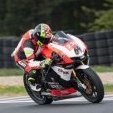
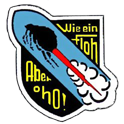




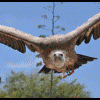


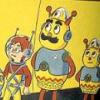
.thumb.jpg.cfc129272ffec824439b15e6013d5952.jpg)



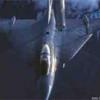
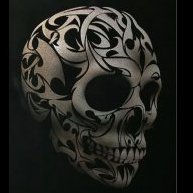

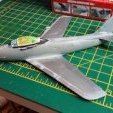
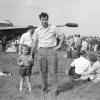
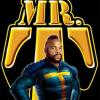

-1-1MINIATURA.thumb.jpg.bd7a7e672869500d45ee6e80478f6f25.jpg)


